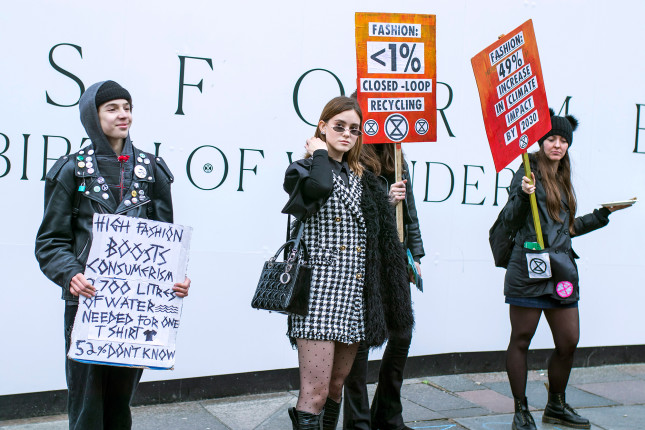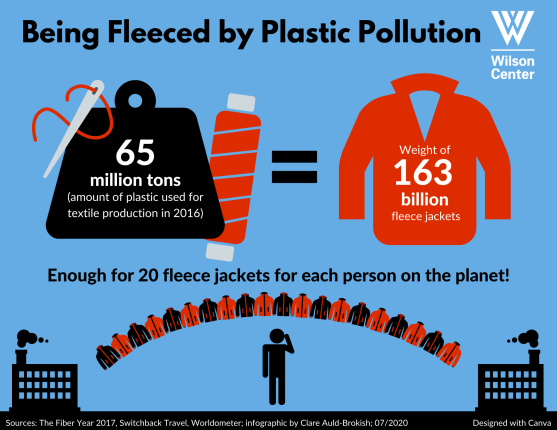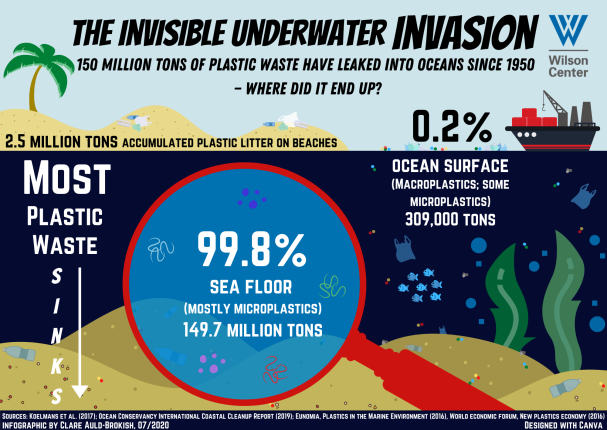-
How Plastic Pollution is Being Woven into Fast Fashion Culture
July 30, 2020 By Catie TobinThe words “plastic pollution” evoke images of discarded plastic bottles and bags, derelict fishing gear, and crushed cigarette butts set on a beautiful beach or floating underwater. In this imagery, the ebb and flow of plastic pollution is visible to the naked eye. But the plastic we can see is only part of the problem. What we do not see so easily are the microscopic, hair-like plastic fibers that are coursing through the water and air, accumulating on beaches, in intertidal zones, and even in Arctic sea ice. These are synthetic microfibers: thin pieces of plastic, a sub-category of microplastics, that resemble a strand of hair. Some research estimates that only about 6 percent of the total mass of plastic entering the oceans is easily visible because much of it readily breaks down into small microplastics and sinks to the seafloor. This invisible underwater invasion of microfibers originates mainly from clothing made from synthetic (read: plastic) fabrics like polyester, rayon, and nylon, and threatens the health of sea life that consumes them. In 2016, 65 million tons of plastic was produced for textile fibers, representing close to 20 percent of the total plastic production for that year. Not only that, but plastics in fashion is responsible for generating enormous amounts of wastewater and emitting huge quantities of carbon.
The Plastic Fabric of our Society
When environmental scientists noticed polyester, a primary component of fabrics such as fleece, was the most common type of microfiber found in the environment, they began investigating how and why textiles were shedding so many microfibers. The 2017 Ellen MacArthur Foundation report, A New Textiles Economy: Redesigning Fashion’s Future, pointed out how in recent decades the fast fashion sector ramped up demand for plastic-infused clothes with “quicker turnaround of new styles, increased number of collections per year, and lower prices.”
Fast fashion relies on enormous virgin plastic production to enable growth; the report estimates that 63 percent of the materials used for clothing in 2015 were virgin plastic compared to less than 3 percent being recycled material. Additionally, more than half of fast fashion clothes are disposed of within a year. In the process of making clothes, plastic additives such as antioxidants, dyes or fire retardants are added to the virgin microfibers. Fabric dyeing and treatment accounts for 20 percent of wastewater worldwide, and rising fast fashion demand could increase the leakage of these dangerous chemicals into the ocean.
Slowing Fast Fashion to Accelerate Plastic-free Fashion
Tackling unsustainable fashion is a complex job that requires that experts from industry, government, and academia come together to address plastic leakage at multiple levels, from the production, fabrication, usage, and washing of synthetic textiles to wastewater treatment plants. (See Figure 1). Clothing and textile companies are starting to address some of the leakage areas and set up incentives to close the loop on microfiber pollution in the ocean. But much more remains to be done. In recognition of the UN Sustainable Development Goals, French President Emmanuel Macron debuted the Fashion Pact at a G7 meeting in 2019. This agreement between 32 companies and 150 brands (including Gucci, Chanel, and Nike) contains a set of shared objectives that the fashion industry can work towards to lessen their environmental impact. Clothing companies and brands are encouraged, but not mandated, to: 1) achieve zero greenhouse gas emissions by 2050, 2) restore natural ecosystems and protect species, and 3) reduce the use of single-use plastic. For example, Stella McCartney is eliminating virgin plastic in her collections by using recycled polyester and upcycling materials.
Similar to Stella McCartney, the brands Everlane, Adidas, Rothy’s, Girlfriend Collective, Patagonia, and H&M have all begun incorporating recycled plastic from polyester, soda bottles, and fishing nets into their products. Some have even made commitments to remove virgin plastic from the supply chain entirely. For Everlane’s ReNew Collection, fabric is made from plastic water bottles collected in partnership with groups in Taiwan and Japan. These items are sorted, sanitized, and ground down into chips, and then melted and spun into a fine yarn that can be used for other new products. Using recycled materials reduces wastewater and carbon emissions from fabric production.
Industry leaders can join the Fashion Industry Charter for Climate Action that calls for net-zero emissions by 2050, as well as the Conscious Fashion Campaign, which works with global leaders to achieve Sustainable Development goals. Additionally, Clean by Design, a program led by the Sustainable Apparel Coalition and advised by the Natural Resources Defense Council, uses the buying power of multinational corporations to minimize environmental impacts of their suppliers abroad. While all voluntary, they are building networks of companies that are looking more seriously at the whole supply chain of fabric, setting a foundation for more ambitious efforts around synthetic fibers and microfiber pollution.
In recognition of the UN Sustainable Development Goals, French President Emmanuel Macron debuted the Fashion Pact at a G7 meeting in 2019. This agreement between 32 companies and 150 brands (including Gucci, Chanel, and Nike) contains a set of shared objectives that the fashion industry can work towards to lessen their environmental impact. Clothing companies and brands are encouraged, but not mandated, to: 1) achieve zero greenhouse gas emissions by 2050, 2) restore natural ecosystems and protect species, and 3) reduce the use of single-use plastic. For example, Stella McCartney is eliminating virgin plastic in her collections by using recycled polyester and upcycling materials.
Similar to Stella McCartney, the brands Everlane, Adidas, Rothy’s, Girlfriend Collective, Patagonia, and H&M have all begun incorporating recycled plastic from polyester, soda bottles, and fishing nets into their products. Some have even made commitments to remove virgin plastic from the supply chain entirely. For Everlane’s ReNew Collection, fabric is made from plastic water bottles collected in partnership with groups in Taiwan and Japan. These items are sorted, sanitized, and ground down into chips, and then melted and spun into a fine yarn that can be used for other new products. Using recycled materials reduces wastewater and carbon emissions from fabric production.
Industry leaders can join the Fashion Industry Charter for Climate Action that calls for net-zero emissions by 2050, as well as the Conscious Fashion Campaign, which works with global leaders to achieve Sustainable Development goals. Additionally, Clean by Design, a program led by the Sustainable Apparel Coalition and advised by the Natural Resources Defense Council, uses the buying power of multinational corporations to minimize environmental impacts of their suppliers abroad. While all voluntary, they are building networks of companies that are looking more seriously at the whole supply chain of fabric, setting a foundation for more ambitious efforts around synthetic fibers and microfiber pollution.
To meet green demands by consumers and shareholders, companies and brands are also seeking a Certified B certification, administered by the non-profit B Lab, indicating that they “meet the highest standards of verified social and environmental performance, public transparency, and legal accountability to balance profit and purpose.”
These actions are an encouraging trend, but few companies are avoiding synthetic fibers to directly take on the issue of microfiber shedding. Moreover, consumers must look at the fine print to assure that they are not being “greenwashed” into thinking a company is doing better than they are for the environment, particularly when it comes to microplastics. When H&M launched its Conscious Collection in 2010, the Norwegian Consumer Authority accused the company of “misleading consumers with overly general sustainability claims,” such as not specifying the amount of recycled material in each garment. Information transparency must be woven into the fabric of these brands so that consumers can fully understand their impact. Additionally, these solutions, including using recycled plastic, do not solve the inevitable release of microfibers into the ocean.The Breakdown of Microfibers
Microfibers shed from fabric through the production and washing of clothes and through normal wear-and-tear. Approximately 0.19 million tonnes of microfibers enter into the environment annually from the production and normal use of synthetic textiles. One load of laundry could, depending on the equipment, release 700,000 microfibers. A study done by Patagonia and University of California, Santa Barbara (UCSB), found that top-load washing machines produced more than twice the microfiber shedding compared to their front-load counterparts. Our wastewater treatment plants can only capture approximately 40 percent of these fibers and the rest flow into rivers, lakes, and oceans.Both their prevalence and our inability to capture them mean synthetic microfibers are a real problem. They travel through soil, water, and even air to all regions of the globe and are thought to comprise up to 35 percent of primary microplastics in the marine environment. Once in the environment, they can be consumed by fish and other wildlife, potentially injuring the health of animals and those that eat them, including humans.
Like the partnership between Patagonia and UCSB, companies and scientists are collaborating to innovate and address microfiber pollution. Products such as the Cora Ball, Guppyfriend, and Filtrol are all designed to be incorporated with washers to catch excess microfibers. All three require the removal and disposal of microfibers by hand and each comes at a cost to the homeowner. While these innovations do not claim to completely solve the problem of microfiber input from washing machines, they are examples of ways to combat the issue at the individual household level.
On Wednesdays We Wear Plastic
The fashion industry is beginning to work towards reducing its carbon and pollution footprint, and consumers are paying attention and demanding more from these companies (online searches for “sustainable fashion” significantly increased between 2016 and 2019). The Ellen MacArthur Foundation argues that current brand actions address more downstream impacts rather than developing better, non-synthetic fabrics in upstream production. These internal and external pressures to reform fashion are creating positive opportunities for innovative solutions in material science and chemistry as well as environmental science. For the former two, there is substantial growth opportunity in developing new textile technologies. For the latter, there is an opportunity at each stage of the supply chain for companies, scientists, environmental watchdogs, and policymakers to fully understand their role in contributing to microfiber pollution in the environment and what the environmental implications are as a result. As an environmental scientist whose Ph.D. dissertation explores the effects of polyester microfibers on oysters in Massachusetts, the gaps in current microfiber research motivate me to continue adding to the current knowledge. My love for the environment is coupled with my love for fashion (who says a lab coat can prevent you from putting together a cute outfit?) and I believe we have a unique opportunity going forward to make discoveries that contribute to a sustainable fashion future. Strengthening the science on the impact of microfibers is critical in informing the textile industry as it moves towards a more sustainable, plastic-free fashion culture.Catie Tobin is a Ph.D. candidate in environmental science at the University of Massachusetts, Boston. As a National Science Foundation IGERT Fellow, she is exploring the environmental and social implications of microfiber ingestion by the eastern oyster, Crassostrea virginica, in Boston Harbor and coastal Massachusetts. Since 2013, Catie has worked as the microplastics researcher for New Jersey-based, ocean advocacy nonprofit, Clean Ocean Action where she led the first assessment of microplastics on New Jersey beaches and in coastal waters. Catie is also the lead for the Microplastics Working Group through the Plastic Free Waters Partnership, in which she brings together scientists, policymakers, educators, and citizens to tackle microplastic pollution in the NY/NJ region and beyond. Sources: B Corporation, CNN, Conscious Fashion Campaign, Cora Ball, Ellen MacArthur Foundation, Eunomia, European Commission, The Fashion Pact, Filtrol, Forbes, Glossy, The Guardian, Guppyfriend, Ideas, Natural Resources Defense Council, Plastics Europe, Sew Dynamic Fabrics, Science of the Total Environment, UC Santa Barbara University Bren School of the Environment, Vogue, UNFCCC, Wired Magazine, Woodrow Wilson Center Lead Photo Credit: People protesting against unsustainable fast fashion in London, Elena Rostunova on Shutterstock.com, All Rights Reserved.
 A Publication of the Stimson Center.
A Publication of the Stimson Center.










